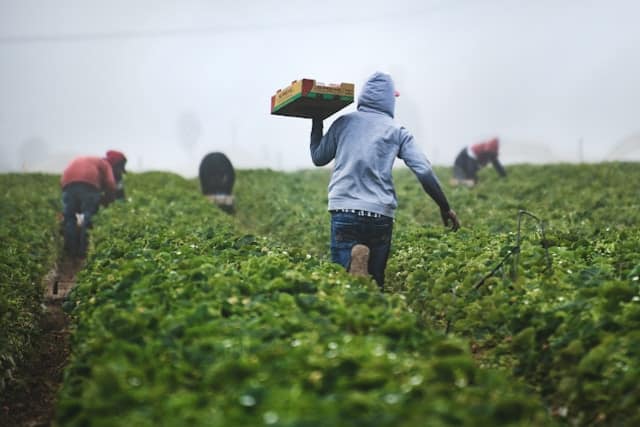Urban agriculture is no longer just a trend for hipster communities or a survival strategy for disaster-prone areas. It’s a vital component of sustainable urban development that’s reshaping our cities and their real estate markets. Urban agriculture is showing tremendous potential in enhancing real estate value, fostering stronger community bonds, and transforming underused lands into productive green spaces.
The Emergence of Urban Agriculture
Urban agriculture, in simple terms, refers to the practice of cultivating, processing, and distributing food in or around a village, town, or city. In the past, farming was exclusively a rural practice. But with the ever-growing populations in urban areas, the need for local food production became apparent. Today, urban farming is increasingly being seen as a viable solution to this problem. It also offers a plethora of benefits that can increase the value of urban and commercial real estate.
A lire également : How to Develop a Comprehensive Digital Marketing Strategy for a Real Estate Launch?
Farms and gardens in urban spaces provide a host of advantages beyond just food production. They serve as educational venues for scholars and locals alike, foster social bonds within the community, and contribute positively to the environment by reducing carbon emissions. In turn, these benefits can lead to increased property values.
Urban Farms: A New Value Proposition for Real Estate
When most people think of farms, they envision vast stretches of land dotted with crops and livestock. However, with recent advancements in agriculture technology, farming has successfully made its way into our cities. Urban farms, ranging from small community gardens to large-scale commercial operations, are springing up on rooftops, in abandoned warehouses, and other underused urban spaces.
A lire en complément : What Are the Latest Innovations in Building Insulation Materials for Energy-Efficient Homes?
Google ‘urban farms,’ and you’ll find countless success stories of urban farms enhancing the value of surrounding properties. For instance, areas that were once characterized by vacant lots and crumbling infrastructure have been transformed into vibrant, green spaces teeming with fresh produce and community life.
Moreover, urban farms provide a unique selling point for real estate developers. Including a farm in a residential or commercial project can attract buyers or tenants who value sustainability and local food production. This can result in higher rental rates, increased occupancy rates, and overall heightened real estate value.
Transforming Communities Through Urban Farming
The impact of urban farming extends beyond enhancing real estate value – it’s also transforming communities. Urban farms encourage community involvement and social interaction, fostering a sense of belonging and mutual support among residents.
Community gardens, in particular, offer social benefits that can indirectly boost real estate value. They bring together diverse groups of people, fostering relationships among neighbors that might not otherwise interact. They provide a space for community members to learn about sustainable farming practices, encouraging a healthy lifestyle and environmental stewardship.
Urban farms also provide fresh, locally-produced food to communities, contributing to food security and reducing dependence on long-distance food transportation. These farms often employ people from the community, providing job opportunities and supporting the local economy.
Crossref-ing Urban Agriculture with Sustainable Development
For urban agriculture to truly enhance real estate value, it needs to be integrated with sustainable development practices. This means using farming systems that are not only productive but also eco-friendly.
The use of green technologies, such as hydroponics and vertical farming, can make urban agriculture more sustainable. These technologies allow for more efficient use of space, water, and nutrients, leading to higher yields compared to traditional farming methods.
Urban farms can also mitigate the effects of climate change by reducing urban heat islands and sequestering carbon. They can improve air and water quality, contributing to a healthier urban environment.
The Future of Urban Agriculture
As urban populations continue to grow, so too will the demand for local, sustainable food production. Urban agriculture is well-positioned to meet this demand, offering a win-win solution for urban dwellers, real estate developers, and the environment.
Looking to the future, the integration of urban farms into residential and commercial developments will likely become more commonplace. From rooftop gardens to indoor vertical farms, urban agriculture will continue to evolve and adapt, providing innovative solutions to urban development challenges.
Remember, the value of real estate isn’t just about the bricks and mortar – it’s also about the quality of the local environment and community. Urban agriculture, with all its benefits, is a key component of this value proposition.
The Role of Technology in Urban Agriculture
Technology plays a pivotal role in the growth and success of urban agriculture. Advancements in agricultural technology are enabling urban farmers to grow food in ways that were previously unimaginable. These technologies, often researched and documented on platforms like Google Scholar, are making urban farming a realistic and profitable venture.
Hydroponics, for instance, is a method of growing plants without soil, using mineral nutrient solutions in a water solvent. This system allows urban farmers to grow crops in small spaces, such as apartment balconies or rooftops, making farming possible in densely populated urban areas.
Vertical farming, another technological advancement in urban agriculture, involves growing plants in vertical layers, typically in a controlled environment. It is particularly beneficial in urban areas where land is limited. Vertical farming can significantly increase crop yield per square meter, making it an attractive option for urban farmers.
In addition to these, new farming technologies are continually being developed and refined, as evidenced by numerous studies available on Scholar Crossref. These include innovations in irrigation systems, crop monitoring and management tools, and sustainable energy sources, all of which contribute to a more efficient and sustainable urban agriculture system.
Moreover, technology is also facilitating the promotion and marketing of urban farms and their products. With the rise of social media and e-commerce platforms, urban farms can now reach a wider audience, increasing their marketability and profitability.
Urban Agriculture: A Key Player in Climate Change Mitigation
Urban agriculture has the potential to play a significant role in mitigating climate change. By producing food locally, urban farms help reduce the need for long-distance food transportation, which is a major contributor to greenhouse gas emissions.
Additionally, green spaces in urban areas, including farms and gardens, help combat the urban heat island effect. This phenomenon occurs when urban areas become significantly warmer than their rural surroundings due to human activities. Urban farms and gardens can help cool these areas by providing shade and releasing moisture into the air.
Moreover, urban agriculture contributes to carbon sequestration, a process through which CO2 is captured from the atmosphere and stored in plants and soil. This helps offset greenhouse gas emissions, thereby reducing the impacts of climate change.
Urban farms can also contribute to a greener version of urban living by promoting sustainable waste management practices. Composting, for instance, is a common practice in urban farms. It involves turning organic waste into nutrient-rich soil, reducing the amount of waste that ends up in landfills while providing valuable nutrients for plant growth.
Conclusion – Urban Agriculture and the Future of Real Estate
As we look towards the future, it’s clear that urban agriculture is not just a passing trend, but rather, a transformative force that’s reshaping our cities and the real estate market. The integration of urban farms into residential and commercial developments is likely to become more prevalent, as developers and buyers alike recognize the value they bring.
As evidence from Google Scholar and Scholar Crossref indicates, urban agriculture has a multitude of benefits – from enhancing food security and promoting community cohesion, to mitigating climate change and contributing to sustainable development.
In addition to these benefits, urban agriculture also offers a unique value proposition for real estate. By transforming underused urban spaces into vibrant, productive green spaces, urban agriculture can significantly enhance the value of surrounding properties.
Looking forward, it’s exciting to envision a world where urban farms are a common feature in our cities. Where residents can enjoy access to fresh, locally produced food, and where the communal and environmental benefits of urban agriculture are fully recognized and valued.
In a world grappling with the challenges of rapid urbanization and climate change, urban agriculture offers a ray of hope and a viable solution for sustainable urban development. It’s time to embrace this green revolution and recognize the transformative potential of urban agriculture.

















Comments are closed